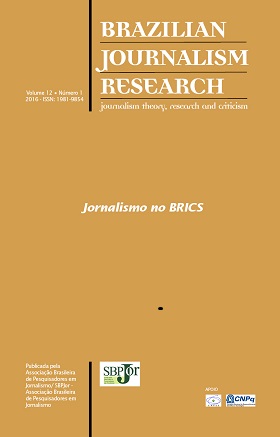Resumen
News agencies have had a privileged role in the development of national and international communication systems, particularly at the periphery of capitalism, being primarily responsible for circulation in the information economy. In countries of Africa, South Asia, Eurasia and Latin America, they constituted prioritised foundations whilst building the institutional structure of the state, designed to boost development. Different models supplied determinants to policies in those countries, such as the choice between public or private ownership, independence or links to global agencies, import or export of information. Taking into account these paradigms and their hybrids, this paper examines the various models of constitution and operation of news agencies that were adopted in emerging countries in the 21st century, nominally the so-called BRICS (Brazil, Russia, India, China, and South Africa), particularly in regards to the State, to ownership and business, and to their respective roles in strategies for national development.Citas
AGUIAR, Pedro. Sistemas Internacionais de Informação Sul-Sul: do pool não-alinhado à comunicação em redes. Dissertação de mestrado defendida na Escola de Comunicação da UFRJ. Orientadora: Suzy dos Santos. Rio de Janeiro: ECO/UFRJ, 2010.
BOYD-BARRETT, Oliver. The International News Agencies. Londres/Beverly Hills: Constable, SAGE, 1980.
BOYD-BARRETT, Oliver. RANTANEN, Terhi. Global and National News Agencies: opportunities and threats in the age of the Internet. in: BRIGGS, Asa. COBLEY, P. (orgs.). The Media: an introduction. Londres: Longman, 2002. 2ª ed.
DANTAS, Marcos. A Lógica do Capital-Informação. Rio de Janeiro: Contraponto, 2002. 2ª ed.
ELLIOTT, Charles W.. Flows of News from the Middle Kingdom: an analysis of international news releases from Xinhua. in: MALEK & KAVOORI (orgs.). The Global Dynamics of News: studies in international news coverage and news agendas. Stamford (EUA): Ablex: 2000. pp.343-388
KRUGLAK, Theodore Eduard. The Role and Evolution of Press Agencies in the Socialist Countries. International Communication Gazette, jan 1975; vol.21: pp.1-18. 17p.
KRUGLAK, Theodore Eduard. The Two Faces of TASS. University of Minnesota Press, 1962.
LERNER, Daniel. SCHRAMM, Wilbur (orgs.). Comunicação e Mudança nos Países em Desenvolvimento. São Paulo: Melhoramentos/EdUSP, 1973.
MARQUES, Márcia. As mudanças nas rotinas de produção das agências de notícias com a consolidação da internet no Brasil. Dissertação de Mestrado defendida na Universidade de Brasília (orientadora: Zélia Adghirni). Brasília: UnB, 2005.
MATTELART, Armand. Comunicação-Mundo: história das ideias e das estratégias. Petrópolis: Vozes, 1994.
PATERSON, Chris. News Agency Dominance in International News on the Internet. in: SKINNER, D., COMPTON, J. and GASHER, M. (orgs.) Converging Media, Diverging Politics: A Political Economy of News in the United States and Canada. Lexington/Rowman and Littlefield, 2005. pp. 145-164. 24p.
RAMOS, Isabel. ORLANDO, Rocío. “Activismo estatal y bloqueo mediático: contiendas por la regulación de la comunicación en el Ecuador”. Corriente Alterna. vol.I, nº 2 (junho de 2012). Quito: Terranueva, 2012.
RANTANEN, Terhi. A Historical Study of News Agencies: the beginning of news agency activity in Russia. Nordicom, 1. 7-12. Gotemburgo: NORDICOM, 1985.
RANTANEN, Terhi. Flows and Contra-Flows in Transitional Societies. in: THUSSU, Daya K. (org). Media on the Move: global flow and contra-flow. Nova York: Routledge, 2007. pp.146-160
SCHRAMM, Wilbur. Comunicação de Massa e Desenvolvimento. Rio de Janeiro: Bloch, 1976.
SHRIVASTAVA, K.M.. News Agencies: from pigeon to internet. Nova Délhi: New Dawn Press/Sterling, 2007.
THUSSU, Daya Kishan. International Communication: continuity and change. Londres: Hodder Arnold, 2006.
TOPUZ, Hifzi. News Agencies in Africa. International Communication Gazette, jan 1962; vol.8: pp.48-52.
XIN, Xin. Xinhua News Agency and Globalization. in: BOYD-BARRETT, Oliver. Communications Media, Globalization and Empire. Eastleigh (Reino Unido): John Libbey, 2006. pp.111-128
Copyright for articles published in this journal is retained by the authors, with first publication rights granted to the journal. By virtue of their appearance in this open access journal, articles are free to use, with proper attribution, in educational and other non-commercial settings.
This work is licensed under a Creative Commons Attribution-NonCommercial-NoDerivatives 4.0 International License.


